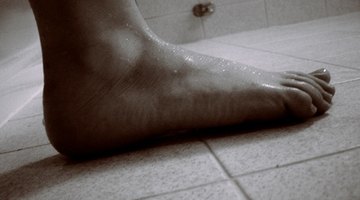Cons of Resurfacing Bathroom Tile
Resurfacing is a process in which ceramic tile and similar materials are stripped down and coated with a new epoxy or urethane layer that is meant to give the tile a new color and surface. Grout lines are also restored at the same time, which can solve mildew and discoloration problems. Resurfacing is less expensive than replacing entire parts of the bathroom, but it does come with negative aspects, including a shorter lifespan and fumes that may be hazardous to some homeowners.
Harmful Acids

In order to properly bond the new layer to the tile, installers must wear away the old glaze to expose the porous tile beneath. Installers do this by using strong acids, which work quickly but are extremely corrosive. If these acids accidentally come in contact with any other part of the bathroom, then they can eat away at stone or walls and cause permanent damage.
Fumes
The urethane coatings that installers use to resurface bathroom tile create very strong fumes, especially in the enclosed space of the bathroom. Installers have to wear masks when they apply the coating and homeowners cannot use their house for several hours afterward. More sensitive people, like those with asthma or pregnant women, must stay away even longer.
Variation in Quality
The quality of a resurfaced bathroom depends on how the coating is installed. Some installers are experienced with applying these coatings and can create a smooth, clean surface. Others may be new to the practice or have only taken a class or two in the subject. It is not guaranteed that installers will all produce results of the same quality.
Life Span
While resurfacing bathroom tile can give the tile longer life, it cannot recreate the tile itself. This means that the resurfacing will not last as long as the original ceramic tile. Ceramic tile tends to last up to 50 years with relatively little care needed. The resurfacing will last only 10 to 20 years before it needs to be redone.
References
Writer Bio
Tyler Lacoma has worked as a writer and editor for several years after graduating from George Fox University with a degree in business management and writing/literature. He works on business and technology topics for clients such as Obsessable, EBSCO, Drop.io, The TAC Group, Anaxos, Dynamic Page Solutions and others, specializing in ecology, marketing and modern trends.
Photo Credits
- pieds image by Ellsing from Fotolia.com
More Articles



